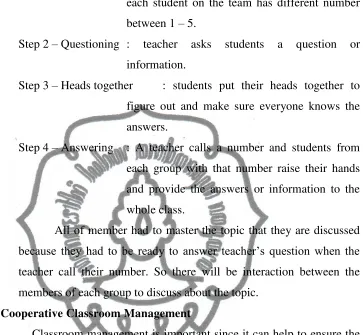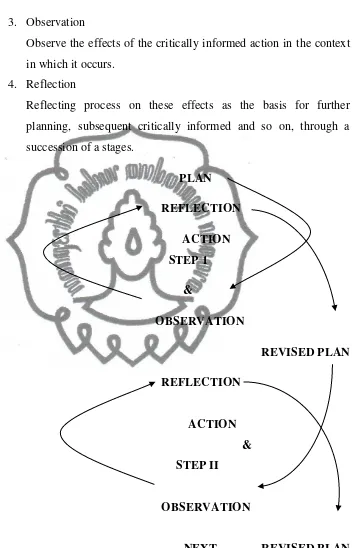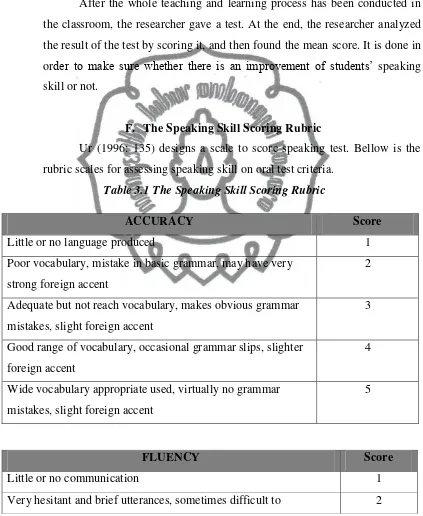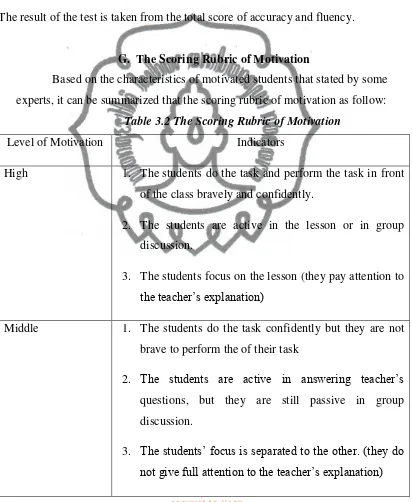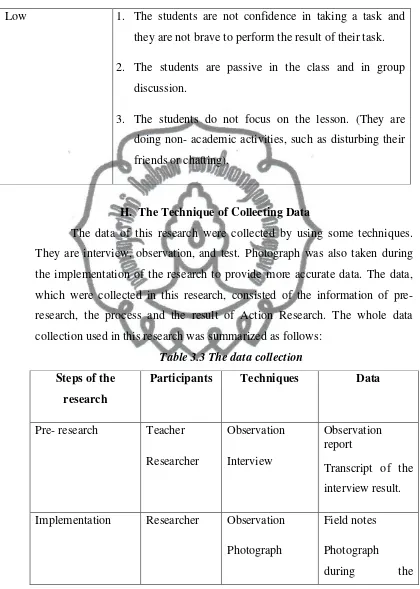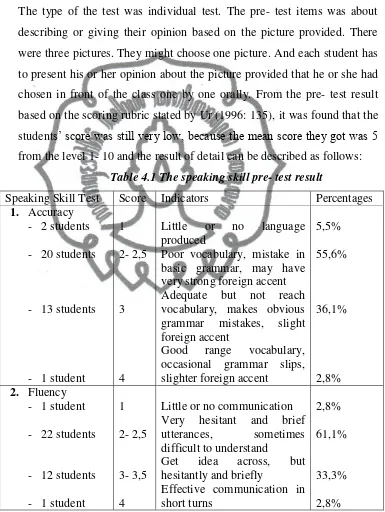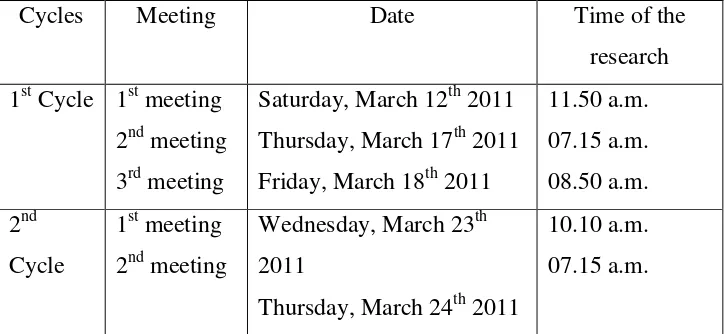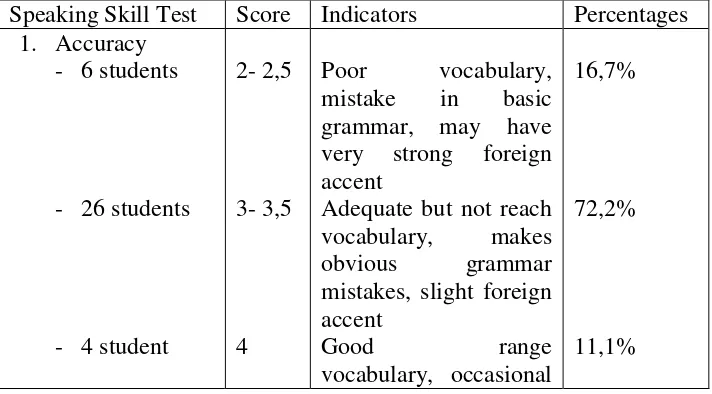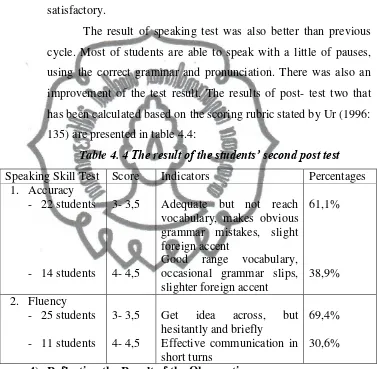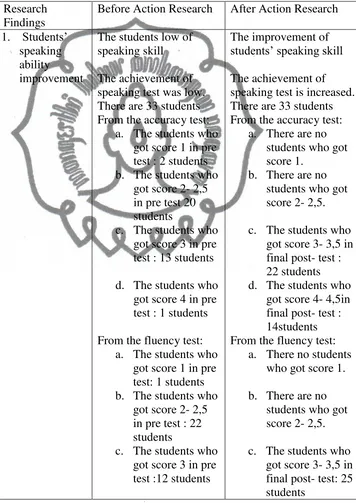commit to user
i
IMPLEMENTING COOPERATIVE LANGUAGE LEARNING
(CLL) TO IMPROVE STUDENTS’ SPEAKING SKILL
(An Action Research at the Eighth Grade of SMP Negeri 5 Surakarta inAcademic Year 2010/2011)
By:
YULI DWI KURNIAWATI
X2207030
Thesis
Presented as Partial Requirements for the Undergraduate Degree of Education
in Teaching Training and Education Faculty of
Sebelas Maret University
ENGLISH DEPARTMENT
TEACHER TRAINING AND EDUCATION FACULTY
SEBELAS MARET UNIVERSITY
SURAKARTA
commit to user
commit to user
commit to user
iv
ABSTRACT
Yuli Dwi Kurniawati. X2207030. “IMPLEMENTING COOPERATIVE
LANGUAGE LEARNING (CLL) TO IMPROVE STUDENTS’ SPEAKING SKILL” (AN ACTION RESEARCH AT THE EIGHTH GRADE OF SMP
NEGERI 5 SURAKARTA IN ACADEMIC YEAR 2010/2011). Teacher Training
and Education Faculty. Sebelas Maret University. 2011.
The objective of this research is to improve students’ speaking skill and motivation in learning English using Cooperative Language Learning (CLL) approach.
The collaborative classroom action research was conducted by the researcher from October, 2010 to June 2011 to the eighth grade students of SMP Negeri 5 Surakarta. There were 36 students as the subjects of the research. At the pre-observation, it was found that the students had difficulties in producing grammatical sentences of their utterances. They produced inappropriate words to express their ideas. The students also had difficulties in pronouncing the words correctly and they did not pay enough participation to the lesson.
In this research, the researcher taught speaking using Cooperative Language Learning (CLL) approach. Cooperative Language Learning (CLL) is a variety of teaching learning approach in which students are divided to work in a group, help and criticize one another. The primary role of learners in cooperative learning is as a member of a group who must work collaboratively with another group member. One of the characteristics of cooperative language learning is a group of learning activities in which there is learners’ interaction to increase the motivation. It means that it is through language that learners come to understand ideas. In delivering ideas, students
need to talk, and through this way, students’ speaking skill can be improved since the
purpose of cooperative learning itself is to stimulate students’ interaction or to make
students talk.
The researcher conducted two cycles of action. There were great improvements resulted from conducting the action. The result of the action showed
that the students’ speaking skill improved as shown in the result of both the
observation of students’ activities during the actions and the results of the pre-test and
the test mean scores. The pre-test mean score was 5 increasing to 7.1 in the
post-test. There were also improvements in students’ behavior. During the action, the
students paid good participation to the lesson. It was proven by their activeness in doing all the assignments. They could collaborate well with other students and fully participate in the lesson.
At the end of the research, the writer gives suggestions for the English teacher. Cooperative Language Learning (CLL) can be chosen as an appropriate
approach in order to improve students’ speaking skill and make the students more
commit to user
v
MOTTO
commit to user
vi
DEDICATION
This thesis is whole-heartedly dedicated to:
1. My beloved parents
2. My Brother and Sister (Wahyu Kurniawan
and Evian Titis P)
3. Johan Setyawan Nugroho
commit to user
vii
ACKNOWLEDGEMENT
First of all, the writer would like to thank Allah SWT for His blessing so that
the writer could finish writing the thesis.
The writer realizes that she wouldn’t have completed the thesis without much help of others. Many people have helped her during the writing of the thesis and it
would be impossible to mention all of them. However, she wishes to give her
sincerest gratitude and appreciation to the following:
1. The Dean of Teacher Training and Education Faculty of Sebelas Maret
University for giving the writer permission to write the thesis.
2. The Head of English Department of Teacher Training and Education Faculty
of Sebelas Maret University who has guided the writer to do this thesis.
3. Her consultants, Drs. Martono, M.A, the first consultant, and Teguh Sarosa,
SS M.Hum, the second consultant, for their patience in guiding the writer to
finish the thesis and for their careful correction, advice, and suggestion.
4. Drs. Djoko Triasmono, M.Pd the headmaster of SMP Negeri 5 Surakarta, who
allowed the writer to carry out the research in his school.
5. Latifa Widyaningrum, S.Pd and Ninuk Retno Wilujeng S.Pd , the English
teacher of SMP Negeri 5 Surakarta, who has helped and given her a chance to
accomplish the research.
6. Her beloved mother who always prays and gives support all time.
7. Her family who always prays and encourages her.
8. Johan Setyawan Nugroho who has accompanied and given her motivation to
move on.
9. Her “best friends”, Anggi, Monic, Mila, Tyas, and Wike for always becoming friends all the time and give her supports and suggestions.
10.Her friends in English Department of year 2007 who cannot be mentioned one
commit to user
viii
The writer also thanks everyone who gives their help and support. Without their
help and support, the thesis would never be like this. She realizes that this thesis still
has many mistakes and inaccuracies. Therefore, the writer accepts gratefully every
suggestion, criticism, and comment from those who concern to this thesis. .
Hopefully, this thesis will be able to give contribution and be useful for the readers,
especially for who are interested in similar study.
Surakarta, June 2011
commit to user 1
CHAPTER I
INTRODUCTION
A. Background of the Study
In Indonesia, English is the first foreign language being learned from
elementary. Learning English is demand for students, especially in this
globalization era, in order to understand knowledge and science which are
mostly written and spoken in English.
According to the Indonesian’s SMP syllabus, time allotment given to
learn English is as much as Indonesian subject. It deals with communicative
competence. Brown (1994: 227) says that communicative competence is
aspects of our competence that enables us to convey and interpret messages
and to negotiate meaning interpersonally within the context. It means that the
students are hoped to be able to use English as a means of communication.
The 2006 curriculum of junior high school states objectives of the
teaching English in the level of Junior High School are as follows:
“Mata pelajaran bahasa inggris di SMP/ MTs bertujuan agar peserta
didik memiliki kemampuan sebagai berikut.
1. Mengembangkan kompetensi berkomunikasi dalam bentuk lisan dan tulis untuk mencapai tingkat literasi functional
2. Memiliki kesadaran tentang hakikat dan pentingnya bahasa inggris untuk meningkatkan daya saing bangsa dalam masyarakat global
3. Mengembangkan pemahaman peserta didik tentang keterkaitan antara bahasa dan budaya.
commit to user
writing”. The students are great in answering some extracted questions, but it was difficult for them to use English in spoken language. The result of pre-
test that researchers conducted showed low scores indicating that they really
low in speaking.
The writer saw some problems that attack the students’ speaking skill
when conducting pre- observation in SMP Negeri 5 Surakarta. The problems
can be seen in this student’s statement, “karena kita kan ada yang nggak tau
grammarnya, trus ngucapinnya kan lidah kita kan beda ama lidah orang luar gitu ya, jadi kalau mau ngucapin kan agak gak gok gak gok gimana”. That statement showed (1) students have difficulties in producing grammatical
sentences of their correct utterances. For example, they say “I like sing instead
of I like singing”; (2) students have difficulties in pronouncing words
correctly. They often pronounce word “know” as “/kno:/”; (3) students are
often producing inappropriate words to express their language function. For
example, in the presentation stage someone said “that’s enough” to close is
wrong; it should be “that’s all”; (4) Students’ utterance is halting and incoherent. When they speak, they think what and how to speak. They only
produce speech on their mind; it needs more time in producing the speech,
and they tend to produce fragmented utterances, pause and use fillers (“em...”,
“err…”, “aaa…” etc), the speech tends to be slower and more hesitant, and the worst, there will be no communication at all since it is very impossible after
there are too much fragmented and incoherent utterances.
Beside, there were also problems that faced students’ speaking skill
from the classroom situation, such as (1) Students were not confident in
practicing a language so they speak slowly. They were still afraid to make
mistake in expressing their ideas through speaking. As the English teacher’s
statement, “ya mungkin karena Bahasa Inggris itu termasuk bahasa
commit to user
Surakarta might occur because the teaching approach used by the teacher does
not motivate students for engaging the students in speaking activities.
Therefore, the teacher has to be able to use her creativity to establish
enjoyable and motivating classroom environment. One of the ways is by
applying the teaching approach that can motivate students to speak in
speaking class.
In solving the problem, the researcher proposes cooperative learning.
Cooperative Learning (CL) is the appropriate approach for teaching speaking.
Cooperative learning is an approach which provides some techniques that can
be used in the classrooms. Cooperative learning can improve students’
speaking skill through activating individuals in a group of learning.
Olsen and Kangan (1992: 192), cooperative learning is an activity in such a way so that learning is dependent on the society structured exchange of information between learners in groups and in which each learner is held accountable for his or her own learning and is motivated to increase the learning of others. Cooperative learning invites students to works together and help each other to learn the materials. It focuses on cooperation rather than competition. It involves all students in teaching learning process so that it could motivate students to be more active.
To reach the better academic achievement of the students, especially
speaking skill, is greatly influenced by the appropriate approach used by the
teacher. This is in line with Brown (1994:74) who says that an approach or
theory of language and language learning takes great importance. Based on
commit to user
by the writer on February 4th 2011, the technique used by the teacher is still
traditional which means speaking class is still dominated by the teacher and
students spent a lot of time in listening to the teacher then talking.
There are reasons for the writer to use Cooperative Language Learning
in her class to improve speaking skill. Cooperative learning implies full
participation of both teacher and student and the interaction of student with
student (as stated by Rivers, 1994). It leads to the capability of asking and
answering/responding questions. Questioning and responding will lead the
learners into the use of listening and speaking as communicative strategy and
for its interdependence that cannot be separated each other. It introduces a
wide range of topics into the classroom, which can lead the learners to a free
interaction. It is one of the main reasons for the writer to choose Cooperative
Language Learning as the technique to improve students’ speaking skill.
Generally, the commonest problem faced by the teacher or lecturer of
speaking is what the learners are interested in talking about. Cooperative
Language Learning introduces a wide variety of topics; it can help them to
develop a feel for what interests their learners. By the using of Cooperative
Language Learning, they can engage the learners in free or guidance
conversations about these topics of interest.
From the explanation above, the researcher tries to relate cooperative
learning in teaching speaking in second grade of senior high school students,
and this research entitles Implementing Cooperative Language Learning
(CLL) to Improve Students’ Speaking Skill (Action Research at the Eighth
Grade of SMP Negeri 5 Surakarta in Academic Year 2010/ 2011)
B. Problems Statement
From the explanation of background of the study, there are some
commit to user
1. Can the use of Cooperative Language Learning (CLL) improve
students’ speaking skill?
2. Can the use of Cooperative Language Learning (CLL) improve
students’ motivation in learning English?
C. Objectives of the Study
The research is conducted to:
1. Identify whether or not Cooperative Language Learning (CLL)
improves students’ speaking skill.
2. Identify whether or not Cooperative Language Learning (CLL)
improves students’ motivation in learning English.
D. Benefits of the Study
The benefits of the study that the writer expects are:
1. For the students, the study can enhance the students’ awareness at using English communicatively rather than theoretically.
2. For the teachers, the benefit is that it can be a reference in solving
problems related to speaking, developing the learning quality and they
can implement this technique in their classroom in order to create
interesting and enjoyable classroom condition.
3. For other researchers, the research will motivate them to study and
find out the better techniques to improve students’ speaking skill.
4. For the writer herself, the study can bring her to a better understanding
commit to user
skills through Cooperative Language Learning. The theory covers the concept of
speaking skill, cooperative language learning, the relationship between
cooperative language learning in improving speaking skill, motivation, rationale
and, hypotheses.
A. Speaking Skill
1. The Nature of Speaking
There are some definitions of speaking stated by some experts.
Speaking is a skill of being able to use language orally. Brindley (1995:19)
makes specifications about oral language. Here, oral can be defined as
speaking. He believes that oral is to:
a. Express oneself intelligibility
b. Convoy intended meaning accurately with sufficient command of
vocabulary
c. Use language appropriate to context
d. Interact with other speakers fluently
It means that speaking should involve intelligibility, accuracy,
appropriateness, and fluency.
According to Syakur (1987: 5), speaking is a complex skill concerned
with components of pronunciation, grammar, vocabulary and fluency.
a. Pronunciation
Pronunciation is the student’s way to utter English words.
Pronunciation is one of the difficult language components of a
grammar made up of the elements or principles to determine how
commit to user
b. Vocabulary
Vocabulary means the appropriate diction which is used in
conversation. Having limited vocabulary is a barrier that precludes
learners from learning a language. Without having a sufficient
vocabulary, one cannot communicate effectively or express ideas in
both oral and written form.
c. Grammar
It concerns with how to arrange a correct sentences in
conversation. It can develop the ability to understand and respond
quickly, and the ability to articulate. The utility of grammar is also to
learn the correct way to gain expertise in a language in oral and written
form.
d. Fluency
Fluency is the ability to speak fluently and accurately suited with
professional necessity. In other words, being fluent means able to keep
the language coming. There may be mistakes, fillers and repetition.
Underwood (1996: 11) states that speaking is a creative process where
speakers are almost always in the position of formulating what they are saying
as a result of behavior of their listeners or as a result of added thoughts of
their own. It means that someone is able to speak up because of his
understanding in his listening to other speaker. So, if he hears incorrect sound,
it will make wrong perception for the listener.
Widdowson (1996: 58-59) defines speaking in the usage sense as
simply the physical embodiment of abstract systems, which involve the
manifestation either of the phonological system or of the grammatical system
of the language or both. In the sense of use, he also defines speaking as part of
reciprocal exchange in which both reception and production play a part. Later
commit to user
participation. It means that speaking involves productive and receptive skill
because it used for communication.
Speaking is one of the abilities people have to communicate with
others. In fact, this is important way in communication in order to build a
good relationship with others. Based on Bygate (1987: vii), speaking is an
undervalued skill. Perhaps this is because we can almost all speak, and so take
the skill too much for granted. Speaking is often thought of as a ‘popular’
form of expression which uses the unprestigious ‘colloquial’ register: literary
skills are not on the whole more prized. This relative neglect may perhaps be
due to the fact that speaking is transient and improvised, and can therefore be
viewed as facile, superficial, or glib. It means that speaking is very important
skill for human being. People can not live alone without communicating each
other because they have social characteristics required by other’s help. For
building a good communication, people must have a good speaking skill.
From the explanation above, it can be concluded that speaking is
creative process of constructing meaning that involves producing, receiving,
and processing information that includes intelligibility, appropriateness,
fluency, and accuracy. In this research, the researcher only focuses on fluency
and accuracy of students’ speaking skill of the eighth grade students of SMP Negeri 5 Surakarta and the criteria assessment of speaking test is taken from
Ur’s criteria assessment of speaking test.
2. Teaching Speaking
Nunan in Kayi (2006) states that what is meant by "teaching speaking"
is to teach ESL learners to:
a. Produce the English speech sounds and sound patterns
b. Use word and sentence stress, intonation patterns and the rhythm of the
second language.
c. Select appropriate words and sentences according to the proper social
commit to user
d. Organize their thoughts in a meaningful and logical sequence.
e. Use language as a means of expressing values and judgments.
f. Use the language quickly and confidently with few unnatural pauses,
which are called as fluency.
To achieve a successful speaking activity in the teaching of speaking,
teachers should know the procedure of teaching speaking, problems in
speaking activity, suggestion for teacher in teaching speaking, and the criteria
of a successful speaking activity.
3. The Types of Classroom Speaking Performance
Brown (1994: 266) states that there are six types of classroom
speaking performance:
a. Imitative
In imitative types, learners spend their time to initiate speech,
for example, they are practicing an intonation contour, trying to
pinpoint a certain vowel sound, etc. Intonation of these kinds is
carried out not the purpose of meaningful interaction, but for focusing
on some particular element of language form. For example is drilling
activity. Drills offer students an opportunity to listen and to repeat
certain string of language that may pose some linguistic difficulty –
either phonological or grammatical.
Here are some guidelines for successful drills:
1) Keep them short (a few minutes of class hour only)
2) Keep tem simple (preferably just one point at a time)
3) Keep them “snappy”
4) Make sure students know why they are doing the drill
5) Limit them to phonology and grammar points
6) Make sure they ultimately lead to communicative goals
commit to user
b. Intensive
Intensive is designed to practice some phonological or
grammatical aspect of language. Intensive speaking can be
self-initiated or it can be even form part of some pair work activity.
c. Responsive
Responsive is short replies to the teacher or students initiated
questions or comments which are usually and do not extend into
dialogue.
d. Transactional (dialogue)
Transactional is extended form of responsive language.
Transactional dialogue is not just limited to give the short respond but
it can convey or exchange specific information.
e. Interpersonal (dialogue)
Interpersonal dialogue is designed for maintaining social
relationships than for the transmission of fact or information.
4. The Procedure of Teaching Speaking
a. Teacher Role
Byrne (1997: 2) states three stages in teaching speaking, as
follows:
1) Presentation stage
In the presentation stage (when the teachers introduce
something new to be learned), the teachers play a role as
informant.
2) Practice stage
In the practice stage (when the teachers allow the
learners to work under their direction), the teachers have a role
commit to user
3) Production stage
In the production stage (when the teachers give the
learners opportunity to work on their own). At this stage the
learners must work independently in performing the speaking
skill they have.
Besides these three roles of each stage, there is another key
role that is the teachers as motivator. The teachers must be able to
motivate their students in order to interest and involve them in what
they are doing.
5. Problems with Speaking Activities
According to Ur (1996: 121), there are some examples of problem
faced by students in speaking:
a. Inhibition
Unlike reading, writing, and listening activities speaking
requires degree of real time exposure to an audience. Learners are
often inhibited about trying to say things in a foreign language in the
classroom or losing fate, or simply shy of the attention that their
speech attracts.
b. Nothing to say
Even if they are not inhibited, learners often complain that they
cannot have anything to say. They have no motivation to express
themselves beyond the guilty feeling that they should be speaking.
c. Low or uneven participation
Only one participant can talk at a time if he or she is to be
heard, and in large group this means that each one will have only very
little talking time. This problem is compounded by the tendency of
commit to user d. Mother tongue use
In classes where all or number of the learners share the same
mother tongue, they may tend to use it because it feels unusual to
speak to one another in a foreign language, and because they feel less
“exposed” if they are speaking their mother tongue. If they are talking
in small groups it can be quite difficult to get some classes,
particularly the less disciplined or motivated ones to keep the target
language.
6. Suggestion for Teacher in Teaching Speaking
Ur (1996: 121-122) defines some suggestion for teacher to solve the
problems of speaking. They are as follows:
a. Use group work
This increases the sheer amount of student talk going on in a
limited period of time and also lowers the inhibitions of students who
are unwilling to speak in front of the full class. It is true that group
work means the teacher can not supervise all students speech, so that
not all utterances will be correct, and students may occasionally slip
into their native language; nevertheless, even taking into consideration
occasional mistakes and mother tongue use, the amount of time
remaining for positive, useful oral practice is still likely to be far more
than in the full-class-set up.
b. Base the activity on easy language
In general, the level of the language needed for a discussion
should be lower than used in intensive language learning activities in
the same class. It should be easily recalled and produced by the
participants, so that they can speak fluently with the minimum of
hesitation. It is a good idea to teach or review essential vocabulary
commit to user
c. Make a careful choice of topic and task to stimulate interest.
On the whole, the clearer the purpose of the discussion more
motivated participants will be. A good topic is one which students can
relate using ideas from their own experience and knowledge. It should
also represent a genuine controversy. Some questions or suggested
lines of thought can help to stimulate discussion. A task is essentially
goal-oriented. It requires the group, or pair, to achieve an objective
that is usually expressed by an observable result such as brief notes or
lists, a rearrangement of jumbled items, a drawing, and a spoken
summary.
d. Give some instructions or trainings in discussion skills
If the task is based on group discussion then it includes
instructions about participation when introducing it. For example, tell
students to make sure that everyone in the group contributes to the
discussion and appoint a chairperson to each group who will regulate
participation.
e. Keep students speaking the target language
Teachers might appoint one of the groups as monitor, whose
job is to remind participants to use the target language, and perhaps
report later to teacher how well the group managed to keep it. Even if
there is no actual penalty attached, the very awareness that someone is
monitoring such lapses helps participants to be more careful.
7. Characteristics of a Successful Speaking Activities
These are the characteristics of a successful speaking activity as
proposed by Ur (1996: 120):
a. Learners talk a lot
As much as possible of the period of time allotted to the
activity is in fact occupied by learner talk. This may seem obvious, but
commit to user
b. Participation is even
Classroom discussion is not dominated by a minority of
talkative participant: all get a chance to speak, and contributions are
fairly evenly distributed.
c. Motivation is high
Learners are eager to speak: because they are interested in the
topic and have something new to say about it, or because they want to
contribute to achieving a task objective.
d. Language is of an acceptable level
Learners express themselves in utterances that are relevant,
easily comprehensible to each other, and of an acceptable level of
language accuracy.
B. Review on Cooperative Language Learning (CLL)
1. The Nature of Cooperative Language Learning (CLL)
Cooperative learning is a group of learning activity organized
so that learning depend on the socially structured exchange of
information between learners in groups and in which each learner is
held accountable for his or her own learning and motivated to increase
the learning of others. (Olsen and Kagan, 1992: 8).
Cooperative Learning offers ways to organized group work to
enhance learning and increase academic achievement. Cooperative
Learning is carefully organized so that each learner interacts with
others and all learners are motivated to increase each other’s learning
(Kessler, 1992: 1).
As what Kessler (1992) stated in cooperative learning
propounded by Dewey, it is an approach to education based on the
commit to user
directed; that learners can be teachers; and those teachers are guides
and facilitators rather than the source of all knowledge and direction.
From the definition above, it can be concluded that cooperative
learning is a group of learning activities that there is an interaction of
each learners and motivated to increase each other learning.
2. The Benefit of Cooperative Learning
Kesser (1992: 7) states that cooperative learning offers three major
benefits:
a. Cooperative Learning provides a richness of alternatives to structure
interactions between students.
b. Cooperative Learning content area learning and language development
needs within the same organizational framework.
c. The variety of ways to structure student practice with lesson material
increases opportunities for individualized instruction, such as
peer-provided clarifications.
Besides, Slavin (1995: 16) says that Cooperative Learning improves
learners motivation because of the rewarding group based on the group
performance. It encourages the learners to exert maximum effort. In
language teaching Cooperative Learning goal is to enhance learner
motivation and reduce learner stress and to create a positive affective
classroom climate (Richards, 2001: 197).
3. Kinds of Cooperative Language Learning (CLL)
There are many kinds of Cooperative Language Learning (CLL),
they are: Students Team Achievement Division (STAD), Jigsaw, Think
Pair Share, Think Pair Square, Round Robin, and Numbered Head
Together. In this research, the researcher only used Think Pair Share and
Numbered Head Together as the method in improving students’ speaking
commit to user
a. Think- Pair- Share
It is built for giving students more time to think and to respond
and to help each other. Think- Pair- Share employs three following
steps:
Step 1 – Thinking : the teacher poses questions or issue associated
with the lesson and asks students to spend a minutes
thinking alone about the answer of the issue.
Step 2 – Pairing : the teacher asks the students to pair off and
discuss what thinking about. Interaction during this
period can be sharing the ideas if a specific issue was
identified.
Step 3 – Sharing : in the final step, the teacher asks the pairs to
share what they have been thinking about with the
whole class.
Think-Pair-Share allows students to think about a response
before sharing them with another student or the class. Students are
often more willing to share an idea with a partner than speaking up in
the class. This strategy allows them to try out their ideas in a
supportive dialog with a partner. Thinking and talking about an idea
also helps students sharpen their ideas as they listen to others. If
students are asked to report out to the whole class, more confident
students get a chance to volunteer the answer for their pair, while less
confident students still hear their ideas presented.
commit to user
All of member had to master the topic that they are discussed
because they had to be ready to answer teacher’s question when the
teacher call their number. So there will be interaction between the
members of each group to discuss about the topic.
4. Cooperative Classroom Management
Classroom management is important since it can help to ensure the
success of the teacher and the activities which are used.
a. The Teacher’s Role
The teacher’s role is generally one facilitating, monitoring
students’ engagements with the process or clarifying information
rather than primarily one of the providing information.
b. The students’ Role
1) Pair Work
As Hammer (1998: 247) states, pair work is a way of
increasing student’s participation and language use. It allows the students to use the language and also encourage the student
cooperation which is itself important for the atmosphere of the
commit to user
2) Group Work
Group work is more dynamic than pair work, there are
more people to react with and against in a group therefore,
there is a greater possibility of discussion. It puts demand on
the student’s ability to cooperate closely with only one other person (Hammer. 1998: 245).
C. The Relationship Between Cooperative Language Learning (CLL) and
the Improvement of Speaking Skill
Cooperative learning is a variety of teaching learning approach in
which students are divided to work in a group, help and criticize one another
efforts or contribution, and receive a group performance score. The primary
role of learners in cooperative learning is as a member of a group who must
work collaboratively with another group member.
In conducting teaching speaking, the teacher should conduct the
activities which involve real communication which are essential for language
learning. Language is used for carrying out meaningful tasks that promote
learning because language that is meaningful to the learner supports the
language process. (Richards and Rodgers, 2001: 223)
According to Crandall, 1999 and kagan, 1995 in Zhang cooperative
language learning creates natural, interactive contexts, where students listen to
each other, ask question, and clarify issues. Group interaction assists learners
in negotiating for more comprehensible input and in modifying their output to
make it more comprehensible to others.
Jing Meng (2010) said that through cooperative learning method,
speaking activities can be highly motivated and students can be willing to
open their mouth instead of being afraid of making mistakes in front of the
whole class. If teachers have set up the activity properly, and can give useful
commit to user
One of the characteristics of cooperative language learning is a group
of learning activities that there is an interaction of each learner to increase the
motivation each others learners. It means that it is through language that
learners come to understand ideas. In delivering ideas, students need to talk,
and through this way, students’ speaking skill can be improved since the
purpose of cooperative learning itself is students interaction or to make
students talk.
D. Review on Motivation
1. The Nature of Motivation
Motivation is important aspect in every occasion. It influences
someone’s work on its process and result. Someone success because of he is
motivated. Motivation also has important role in learning. So the teacher
should understand about motivation.
Some experts suggest some definitions of motivation. Brophy (1993:
3) defines that motivation refers to students’ subjective experiences,
especially their willingness to engage in lesson and learning activities and
their reasons for doing so. According to Weiner in Elliot et al (2000: 332)
defines that motivation is an internal states that arouses us to action, pushes us
in particular direction, and keep us engaged in certain activities.
From the definition above, it can be concluded that motivation is
subjective experiences or internal states that arouses to an action, pushes in
particular direction, especially willing to engage in lesson and learning
activity.
2. Types of Motivation
Elliot et al (2000: 233) distinguish two type of motivation: Intrinsic
motivation and extrinsic motivation. Intrinsic motivation is the desire of
students themselves to learn, without the need for external motivation. When
commit to user
activities lies within the activity itself. Then the motivation is to intrinsic. This
indicates that the motivation comes from the learners’ needs, wants, and
desires for their own purpose. This motivation exists when the learner learns
because of an inner desire to accomplish a task successfully, whether it has
some external value or not.
Extrinsic motivation is rewards and inducements external to students
such as scores, prizes, and other rewards. Students’ reason for doing an
activity is to gain something outside the activity itself, such as getting the best
score, obtaining financial rewards. The motivation is likely to be extrinsic.
Thus, it is clear that the extrinsic motivation exists when the learners are
motivated by an outcome that is external. Extrinsically motivated students
carried out task in anticipation of reward from outside and beyond themselves.
Intrinsic motivation gives more contribution to students for learning
than extrinsic motivation. But in motivation students to learn, the external
stimulus is also needed by the students to reach their goals. This stimulus is
used to improve students’ motivation in teaching learning process. 3. The Function of Motivation in English Learning
Elliot et al (2000:332) sums up that motivation is an important
psychological construct that affects learning and performance in four ways:
a. Motivation increases an individual’s energy and activity level. It influences the extent, to which an individual is likely to engage in a
certain activity intensively or half-heartedly.
b. Motivation directs an individual toward certain goals. Motivation
affects choices people made and the result they find rewarding.
c. Motivation promotes initiation of certain activities and persistence in
those activities. It increases the possibility that people will begin
something on their own, persist on the face of difficulty, and resume a
commit to user
d. Motivation affects the learning strategies and cognitive processes an
individual employs. It increases the possibility that people will pay
attention to something, study and practice it and try to learn it in a
meaningful fashion. It also increases the possibility that they will seek
help when they meet difficulty.
4. The Characteristics of Motivated Students
Ur (1996:275) says that motivated learner is someone who is willing
or even eager to invest effort in learning activities and to progress. Moreover
this learner motivation makes teaching and learning immeasurably easier and
more pleasant as well as productive. Naiman (in Ur, 1996:275) also adds that
the most successful learners are not necessarily those whose language comes
very easily; they are those who display certain typical characteristics, most of
them clearly associated with motivation. There are: 1) Positive Task
Orientation. The students who are motivated in learning are willing to tackle
tasks and challenges and have confidence in his or her success, 2)
Ego-Involvement. The student finds it important to succeed in learning in
maintaining and promote his or her own positive self image, 3) Need for
achievement. The student has a need to achieve, to overcome difficulties and
succeed in what he or she sets out to do, 4) High aspiration. The student is
very aware of the goals of learning or of specific learning activity and directs
his or her efforts toward achieving them, 5) Perseverance. The student
consistently invests a high level of effort in learning and is not discouraged by
setbacks or apparent lack of progress, 6) Tolerance of ambiguity. The student
is not disturbed of frustrated by situation involving a temporary lack of
understanding or confusion; he or she can live with theses patiently, in
confidence that the understanding will come latter.
commit to user
various student’s attitude to foreign language. For one student, learning a
language is personally significant, he is motivated to language learning
(though motives may differ: self-actualization, high achievement motivation,
goal orientation, avoidance of failure); for another student, language is a
heavy burden which he has to carry, and he does not hide his boredom. But
this situation can be understood differently by a teacher who can think
critically: it is mostly a sign which reveals whether the teaching methods and
approaches are effective and relevant to students’ need.
E. Rational
Students of SMP Negeri 5 Surakarta find the difficulties in learning
speaking skill. The students are not fluent, their utterances are often halting
and incoherent, and find it difficult to express ideas logically and pronounce it
correctly. They are not interested in English class because they think that
English is difficult subject. It may be caused by their never practicing their
oral English.
Based on the pre-observation, it was found that students’ difficulties
were related to their low motivation in learning English, and a teacher
dominate in teaching learning process. To overcome the problems above,
here, the writer decides to use cooperative language learning as a technique.
Cooperative language learning is group learning activity organized in such a
way that learning was depend on the socially structured exchange of
information between learners in group and in which each learner is held
accountable for his or her own learning and is motivated to increase the
learning of others.
From the explanation above, it can be assumed that cooperative
language learning can improve the speaking skill at the eight grade students of
commit to user
F. Hypothesis
Considering carefully the theory underlying speaking skill and
cooperative language learning technique, the writer assumes that cooperative
language learning can improve the speaking skill of the eight grade students
commit to user 24
CHAPTER III
RESEARCH METHODOLOGY
A. The Setting of the Research
In this study, the researcher did the research at SMP Negeri 5
Surakarta as the place of the research where the researcher teaches English. It
is located at Diponegoro Street 45, Surakarta 57131.
B. The Subject of the Research
The subject of this research is the eighth grade students of SMP Negeri
5 Surakarta in the academic year 2010/2011. This research uses one class as
the research subject that is 8F. There are 36 students in this class that consist
of 17 girls and 19 boys. The location of the classroom is not suitable to do a
lesson activity. Because it near football yard, so sometimes some voice of
football activities is heard by the students when they got a lesson. It caused
the students can not give their full attention to the lesson, because their
attention separate to the outside of the class. The facility in the class is not
good enough. The classroom is too small for 36 students. There is a
whiteboard, a cupboard, an announcement board, chairs and tables for
students and teacher.
C. The Method of the Research
In this study, the research designed by the researcher is classroom
action research. Kemmis in Hopkins (1993: 44) states that action research is a
form of self-reflective inquiry conducted by participants in a social interaction
situation (including education) in order to improve educational practice by
group or participants and by means of own reflection upon effects of these
commit to user
According to Ebbutt (1985) in Hopkins (1993: 45), action research is
about the systematic study of attempts to improve educational practice by
groups of participants and by means of their own practical actions and by
means of own reflection upon the effects of those actions.
Furthermore, Kemmis and McTaggart (1988) in Nunan (1992: 17)
state that there are three characteristics of the action research. Firstly, the
action research is carried out by practitioners rather than outside researchers,
secondly, the kind of the action research is collaborative, and thirdly, the
action research is aimed at changing things.
From the definition above, it can be concluded that action research
means a systematic study carried out by practitioners in collaboration of
teachers and researcher in a form of self-reflective inquiry of their own
reflection upon the effects of those actions in order to improve educational
practice.
In this study, the classroom action research the researcher does is
aimed at overcoming the students’ problems in speaking skill by means of cooperative language learning. This classroom action research is carried out
by the researcher collaboratively with the teacher of the eight grade students
of SMP Negeri 5 Surakarta by implementing cooperative language learning.
D. The Model of Action Research
Kemmis and McTaggart in Burns (1999: 32), the implementation of
Action Research includes four steps as follows:
1. Planning
Develop a plan critically informed action to improve what is
already happening.
2. Action
commit to user
3. Observation
Observe the effects of the critically informed action in the context
in which it occurs.
4. Reflection
Reflecting process on these effects as the basis for further
planning, subsequent critically informed and so on, through a
succession of a stages.
PLAN
REFLECTION
ACTION
STEP 1
&
OBSERVATION
REVISED PLAN
REFLECTION
ACTION
&
STEP II
OBSERVATION
NEXT REVISED PLAN
commit to user
E. The Procedure of Action Research
The procedures of action research that was done in this research are as
follows:
1. Identifying the problem
The researcher identified the problem before planning the action. The
problem referred to the students’ difficulty in learning speaking. The problem was caused by the way the teacher delivered the material of the lesson which
was not interesting to the learners. It was obtained by observing the teaching
learning process, interviewing, and conducting a pre-test.
2. Carrying out the real classroom research
a. Planning the action
In this step, the researcher prepared everything related to the
action as follows:
1) Planning the steps and technique for delivering the material in
the form of lesson plan.
2) Designing the steps in doing the action.
3) Preparing the material.
4) Preparing sheets for classroom observation (to know the
situation of teaching learning process).
5) Preparing teaching aids.
6) Preparing a test.
It was done to know whether students’ speaking could be improved or not.
b. Implementing the action
In this step, the researcher implemented the teaching and
learning activities of speaking skill through cooperative language
learning. The real implementations were generally presented as
commit to user
1) The researcher greeted the students and checked the students’ attendance at the beginning of the class.
2) The researcher gave guiding question to the students in order to
attract students’ interest.
3) The researcher told students what they are going to learn on that
day.
4) The researcher presented the material.
5) The researcher asked some students to give their opinion based
on the theme given.
6) The researcher gave explanation about the words that used to
express an opinion.
7) The researcher gave explanation about grammar that used.
8) The researcher gave drilling to help students in pronouncing the
words correctly.
9) The researcher divided students into some groups and gave a
picture to them. They worked it in group.
10)The researcher called a number and students from each group
with that number raised their hands and provided the answers or
information in the whole class.
11)The researcher gave evaluation of the pronunciation, and
corrected their sentences in expressing an opinion. The
researcher drilled the mispronunciation to the students.
12)After doing practices, the researcher reviewed the material.
c. Observing the action
In this step, researcher observed all of the activities in the
teaching and learning process. It is done during the teaching and
learning process. The researcher also took notes related of the teaching
commit to user
researcher to observe all of the activities happening in the teaching and
learning process.
Burns (1999: 81) distinguishes some basic factors which
should be considered in order to help guiding observations and make
them more manageable:
1) Decide on a focus for the observation which is relevant to your
group’s research.
2) Identify a specific physical location in which the observation
will be conducted (e.g. playground, coffee area, classroom,
reading corner).
3) Consider the group or individual to be observed (e.g. whole
class, student group, a mixed-gender pair, individual student).
4) Record the events as they happen or as soon as possible after
they happen.
5) Be as objective and precise as possible in your observations and
avoid using attitudinal or evaluative language that makes
inferences about people’s behavior or thinking (e.g. ‘surly’, ‘anxious’, ‘unwilling’, and so on).
6) Try to record complete events or incident. This allows a more
inclusive and holistic picture of the situation to emerge, so that
ordinary as well as unusual events are observed.
7) Develop a system for recording that fits in with other activities
occurring in the context of the observations.
Based on the guide observation above, the researcher did the
observation with the rule as follows:
1) The researcher decided the focus of observation that is
commit to user
2) The researcher prepared the instrument to know the progress of
speaking skill and students’ motivation. For the speaking skill,
the researcher had prepared pre-test, post-test 1 and post-test 2
to measure the improvement of students’ speaking skill. The researcher used speaking rubric for measuring the speaking
score. The researcher focused on students’ speaking fluency
and accuracy. And for the students’ motivation, the researcher
had prepared a note to write down all of activities during the
lesson and did the interview with the students after
implementing the action.
3) The researcher did the observation in the classroom of 8F as
the physical location. The researcher did the observation to the
whole class.
4) The researcher recorded the events that had happened by
making field notes and took photographs of all activities done
in the process of teaching and learning.
5) The researcher did the observation as objective and precise as
possible and avoided using attitudinal that made inferences
about students’ behavior or thinking.
6) The researcher recorded a complete events or incidents by
making notes and took photographs.
7) The researcher developed other activities which occurred in the
context of observation and record them in the field notes.
d. Reflecting the observation result
In this step, the researcher reflected critically on what has
happened and evaluated all actions in the cycle. The researcher
observed what she had done in order to find out the weaknesses and
commit to user
Through the observation, the researcher saw whether the students
were active or passive during the teaching and learning process.
3. Doing evaluation
After the whole teaching and learning process has been conducted in
the classroom, the researcher gave a test. At the end, the researcher analyzed
the result of the test by scoring it, and then found the mean score. It is done in
order to make sure whether there is an improvement of students’ speaking skill or not.
F. The Speaking Skill Scoring Rubric
Ur (1996: 135) designs a scale to score speaking test. Bellow is the
rubric scales for assessing speaking skill on oral test criteria.
Table 3.1 The Speaking Skill Scoring Rubric
ACCURACY Score
Little or no language produced 1
Poor vocabulary, mistake in basic grammar, may have very
strong foreign accent
2
Adequate but not reach vocabulary, makes obvious grammar
mistakes, slight foreign accent
3
Good range of vocabulary, occasional grammar slips, slighter
foreign accent
4
Wide vocabulary appropriate used, virtually no grammar
mistakes, slight foreign accent
5
FLUENCY Score
Little or no communication 1
commit to user
The result of the test is taken from the total score of accuracy and fluency.
G. The Scoring Rubric of Motivation
Based on the characteristics of motivated students that stated by some
experts, it can be summarized that the scoring rubric of motivation as follow:
Table 3.2 The Scoring Rubric of Motivation
Level of Motivation Indicators
High 1. The students do the task and perform the task in front
of the class bravely and confidently.
2. The students are active in the lesson or in group
discussion.
3. The students focus on the lesson (they pay attention to
the teacher’s explanation)
Middle 1. The students do the task confidently but they are not
brave to perform the of their task
2. The students are active in answering teacher’s questions, but they are still passive in group
discussion.
3. The students’ focus is separated to the other. (they do
not give full attention to the teacher’s explanation)
understand
Get idea across, but hesitantly and briefly 3
Effective communication in short turns 4
commit to user
Low 1. The students are not confidence in taking a task and
they are not brave to perform the result of their task.
2. The students are passive in the class and in group
discussion.
3. The students do not focus on the lesson. (They are
doing non- academic activities, such as disturbing their
friends or chatting).
collection used in this research was summarized as follows:
commit to user
Interview Transcript of the
interview result
1. Observation
Burns (1999: 80) says that observation is taking regular conscious
notice of classroom action and occurrences, which are particularly relevant to
the issues or topics being investigated.
In this research, an observation was done in the pre- observation and
in the implementation of the research. In pre- research, observation was
conducted to get information about classroom environment, class condition,
and teaching learning techniques. In the implementation, the observation was
done by the researcher and the teacher as collaborator. In this way, the
observer observed, make field notes, and take photograph of all activities done
in the process of teaching and learning. Observations are ways of finding out
more about the students’ response, students’ behavior, and students’ activities
commit to user
2. Interview
According to Burns (1999: 17), interviews and discussions are face-to
face personal interaction, which generate data about the research issue and
allow specific to be discussed from other people perspective.
The researcher interviewed the teacher and the students about the way
she implemented the material, and the problem faced. The researcher also
interviewed the students about their response about learning speaking skill
through Cooperative Language Learning (CLL). The researcher did the
interview before and after conducting research in order to know the teacher’s
view of the teaching learning process, students’ speaking skill, and students’
motivation.
Interview comes in many different forms. As stated by Wallace (1998:
146), there are three broad categories of interview as follows:
a. Structured interview
Structured interview is an interview that has a very tight
structured and in which the question will probably be read from a
carefully prepared interview schedule.
b. Unstructured interview
Unstructured interview can be quite free-wheeling, without
losing sight of the research purpose. This open-ended approach can be
revealed which might otherwise be withheld in a more formal setting.
c. Semi-structured interview
Semi-structured interview is a kind of compromise between the
two extremes. There will almost certainly be a prepared interview
schedule, but most of the questions will be probably open questions. It
combines a certain degree of control with a certain amount of freedom
commit to user
In this research, researcher used semi-structured interview. The
researcher made a schedule first before doing the interview, and
prepared the questions for interview. The questions are related to the
students’ speaking skill, the implementation of Cooperative Language
Learning (CLL) and students’ motivation.
Wallace (1998: 147-150) states the guidance interview as
follows:
a. The time
Time is an important aspect of interviewing for several
different reasons. Powney and Watts in Wallace (1998: 147) suggest
that for each hour of interviewing, a further three (making
arrangement, possibly travelling to the interview venue, and the
analyzing) should be allowed for preparation and summary – and this
does not include transcription.
The researcher did the interview in the beginning and the end
of the research. The place of the interview is in the language
laboratory. The researcher made the arrangement of the questions for
the interviewer (students and teacher), analyzing the result of the
interview and made transcript of interview result.
b. Recording interview data
There are three ways in which interview data can be recorded.
They are:
1) Simple recall
This way is depend on interviewer memory. When the
interviewer used this approach, interviewer’s recollection should
be written down or audio recorded as soon as possible after the
commit to user
2) Note taking
In this way, the interviewer makes note during the interview.
Note taking may be more difficult, as there is an obvious conflict
between being an attentive and reactive listener on the one hand
and taking extensive notes on the other.
3) Taping
In this way, the interviewer does the interview through audio
or video. The tape will have to be listened to or watched again and
also may have to be transcribed, either in whole or in part.
In this research, the researcher used taping when the interview
did. The researcher used audio to record the conversation between
the interviewer (researcher) and the interviewee (teacher and
students). Taping way is the richest approach to do the interview.
Because the researcher can switch on again the record of the
interview in order to make the transcript of the interview.
c. Individual and group interview
Most interviews are one-to-one, but it is also possible to have
an interview with a group, which could take the form of a kind of
structured discussion.
In this research, the researcher did the interview individual. It
means that, the researcher did the interview one-to-one to the teacher
and students. In the beginning of the research, the researcher asked to
the teacher about the difficulties are faced by students and how far the
students’ motivation in learning English. The researcher asked to the
students about the way they are learning English, the difficulties that
are faced, their motivation. In the end of the research, the researcher
asked to the teacher the way she implemented the material to teach
commit to user
English. The researcher asked the students about students’ response or comments about the way researcher deliver and implemented
Cooperative Language Learning (CLL), students’ feeling when
researcher taught them by Cooperative Language Learning (CLL) to
teach speaking skill, and students’ motivation.
d. Prior notification of questions
Interviewees may be more relaxed if they know what questions
they are going to be asked. It can help them to provide fuller, more
informative answer.
The researcher showed the questions first to the teacher and
students before the interview happen. After the interviewer read the
questions, researcher started interview the interviewer.
e. Conduct of the interview
Interview should begin and finish on time. The atmosphere
should be relaxed and friendly.
The researcher did the interview as schedule that it has been
made by researcher and interviewer. The location was on laboratory
language. The situation was relaxed and friendly because there is an
air-conditioner on the room, so that the condition when the interview
happens was not hot. The situation is quiet enough so that both of
researcher and interviewer can focus on the interview. The recording
machine to record the conversation is in good condition. So that the
researcher conducted the interview was run well.
f. Interviews: variety of focus
Powney and Watts in Wallace (1998: 149) state that interview
focus is used to elicit response from the interviewer.
In this research, the interview focus that is used by researcher
commit to user
1) The interview schedule. The researcher made an
appointment to the interviewer.
2) Interviewing the teacher. The researcher asked the teacher
to see and to observe the way she implemented
Cooperative Language Learning (CLL) to teach speaking
skill and to improve students’ motivation. After that, the
researcher asked to the teacher for her reaction and her
comment at that point.
3) Interviewing students. The researcher implemented
Cooperative Language Learning (CLL) to teach speaking
skill and to attract students’ motivation in each meeting for
two cycles. The researcher asked students’ about their
feeling, their comment, and their reaction before and after
the implementation.
3. Test
The researcher also gave speaking test in the end of every cycle. The
test was about giving their opinion of a picture of tourist resort that has been
provided. The score was involved their accuracy and fluency. The result is
used to find the improvement of the students’ speaking skill.
I. The Technique of Analyzing Data
To analyze the data, the researcher used qualitative and quantitative
technique.
1. Qualitative
The researcher analyzed the data of implementation
cooperative language learning inn teaching speaking skill through
